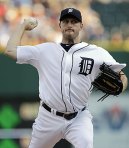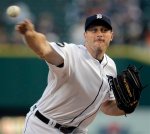Justin Verlander’s Brilliance
 Though just 28 years old, Justin Verlander has had plenty of ups and downs in his career. He has tossed two no-hitters in his career, more than Bob Gibson, Pedro Martinez and Greg Maddux combined. Verlander led the majors in innings pitched (240) and strikeouts (269) in 2009 and tied for the league in wins with 19, but that was coming off a season in which he finished with 17 defeats, the most losses of any American League pitcher. In 2007, he had a .750 winning percentage, the best in the AL, but also hit 19 batters and threw 17 wild pitches, both of which were the worst in the majors. Everything has come together for him in 2011.
Though just 28 years old, Justin Verlander has had plenty of ups and downs in his career. He has tossed two no-hitters in his career, more than Bob Gibson, Pedro Martinez and Greg Maddux combined. Verlander led the majors in innings pitched (240) and strikeouts (269) in 2009 and tied for the league in wins with 19, but that was coming off a season in which he finished with 17 defeats, the most losses of any American League pitcher. In 2007, he had a .750 winning percentage, the best in the AL, but also hit 19 batters and threw 17 wild pitches, both of which were the worst in the majors. Everything has come together for him in 2011.
Instead of leading the league in losses, wild pitches and hit batsmen like he has in years past, Verlander’s 2011 season has him leading the majors in both wins (24), innings pitched (244), batting average against (.190), hits allowed per nine innings (6.1), WHIP (0.910) and strikeouts (244). If that wasn’t enough, he is also leading the American League with a 2.29 ERA, a 178 Adjusted ERA-Plus and .828 winning percentage. Just about the only categories Verlander doesn’t lead the league in are walks issued per nine innings, in which he is eighth in the AL with 2.07, and strikeout-to-walk ratio, where he is third with a 4.36 mark.
 Another way of looking at his success is by going through each of his starts. Verlander has gone at least six innings and thrown no fewer than 104 pitches in each of his 33 starts. He has allowed four runs or more in an outing just four times all season.
Another way of looking at his success is by going through each of his starts. Verlander has gone at least six innings and thrown no fewer than 104 pitches in each of his 33 starts. He has allowed four runs or more in an outing just four times all season.
Verlander has also had a number of purely dominant stretches this year. During one nine-start stint from May 29 through July 10, he went 8-1 with a 0.75 ERA and .182 batting average against in 72 innings while allowing 46 hits, walking 10 and striking out 74 batters. During that stretch, Verlander’s shortest outing was seven innings pitched. Only one pitcher has had that dominant of a stint this season. Cliff Lee’s current nine-start stretch since August 4, in which he is 6-1 with a 0.75 ERA and .198 BAA in 71.2 innings pitched while allowing 50 hits, walking 10 and striking out 74 hitters, is a run strikingly similar to that of Verlander’s in midseason.
 The next stop for Justin Verlander is the postseason as the Detroit Tigers have clinched the AL Central division. During the 2006 playoffs, he made four starts, going 1-2 with a 5.82 ERA and 1.662 WHIP in 21.2 innings while allowing 26 hits, walking 10 and striking out 23. The Tigers were able to reach the World Series that year, but Verlander struggled mightily. His success in 2011 has given the Tigers hope of another World Series appearance. As the ace of Detroit’s staff, Verlander will make, if needed, at least two starts per series should the Tigers continue to advance. If the past is any indication, Verlander will learn from his playoff failures and turn them around into virtually unhittable outings this October.
The next stop for Justin Verlander is the postseason as the Detroit Tigers have clinched the AL Central division. During the 2006 playoffs, he made four starts, going 1-2 with a 5.82 ERA and 1.662 WHIP in 21.2 innings while allowing 26 hits, walking 10 and striking out 23. The Tigers were able to reach the World Series that year, but Verlander struggled mightily. His success in 2011 has given the Tigers hope of another World Series appearance. As the ace of Detroit’s staff, Verlander will make, if needed, at least two starts per series should the Tigers continue to advance. If the past is any indication, Verlander will learn from his playoff failures and turn them around into virtually unhittable outings this October.
Scherzer Maturing
 26-year old right-hander Max Scherzer will take the mound tonight at PNC Park in Pittsburgh. Scherzer is bidding to become the first Tigers pitcher since Vern Kennedy in 1938 to have a 7-0 record before June. Records may sometimes be misleading, but in seven of his nine starts, Scherzer has allowed two runs or less. He has a better strikeout ratio (8.3 K/9) than Josh Beckett, Dan Haren, CC Sabathia David Price and Chris Carpenter. Scherzer has still yet to allow an extra-base to a cleanup hitter all year.
26-year old right-hander Max Scherzer will take the mound tonight at PNC Park in Pittsburgh. Scherzer is bidding to become the first Tigers pitcher since Vern Kennedy in 1938 to have a 7-0 record before June. Records may sometimes be misleading, but in seven of his nine starts, Scherzer has allowed two runs or less. He has a better strikeout ratio (8.3 K/9) than Josh Beckett, Dan Haren, CC Sabathia David Price and Chris Carpenter. Scherzer has still yet to allow an extra-base to a cleanup hitter all year.
Scherzer possesses an incredible trio of pitches. His fastball sits in the mid-90s, but Scherzer keeps hitters off-balance with a disappearing changeup and back-breaking slider.
“His stuff at times,” one scout told ESPN’s Jayson Stark, “is the equal of [Justin] Verlander’s.”
 While his stuff can be the equivalent of fellow teammate Verlander, Scherzer did not always know how to use it. Scherzer was so bad in his first 8 starts last year (1-4, 7.29 ERA, .323 BAA, 54 hits allowed in 42 innings) that Detroit sent him down to Triple-A. Two dominating starts later, Scherzer was back in the big leagues but as a totally different pitcher. In 23 starts that spanned until the end of the season, Scherzer went 11-7 with a 2.46 ERA. In 153.2 innings, he allowed only 120 hits and struck out 158 hitters. Opponents would hit just .220 against him during that span.
While his stuff can be the equivalent of fellow teammate Verlander, Scherzer did not always know how to use it. Scherzer was so bad in his first 8 starts last year (1-4, 7.29 ERA, .323 BAA, 54 hits allowed in 42 innings) that Detroit sent him down to Triple-A. Two dominating starts later, Scherzer was back in the big leagues but as a totally different pitcher. In 23 starts that spanned until the end of the season, Scherzer went 11-7 with a 2.46 ERA. In 153.2 innings, he allowed only 120 hits and struck out 158 hitters. Opponents would hit just .220 against him during that span.
In those final 23 starts of last year, Scherzer became a pitcher, not a thrower. He relied on his fastball much less and used his devastating off-speed pitches much more often. According to Fangraphs, Scherzer threw his fastball 65% of the time in 2010 compared to 71% in 2009 with Arizona. His changeup rate rose from 16.7% to 19.8% and he threw his slider 15.2% of the time in 2010 compared to 12.4% in 2009. Scherzer has continued to throw his fastball less in his dominant 2011 season, using his fastball 62.8% of the time and increasing his slider usage rate to 18.5%.
 It seems as if those two starts in Triple-A were a wake up call to Scherzer. He was always a talented pitcher, but never seemed to know how to best use his pitches until he returned to Detroit in late May last year. His development has possibly given the Tigers baseball’s best 1-2 punch at the top of the rotation. Power pitching dominates in the playoffs, and with the maturation of Scherzer, the Tigers rotation is one that no opposing team would want to see come October.
It seems as if those two starts in Triple-A were a wake up call to Scherzer. He was always a talented pitcher, but never seemed to know how to best use his pitches until he returned to Detroit in late May last year. His development has possibly given the Tigers baseball’s best 1-2 punch at the top of the rotation. Power pitching dominates in the playoffs, and with the maturation of Scherzer, the Tigers rotation is one that no opposing team would want to see come October.
